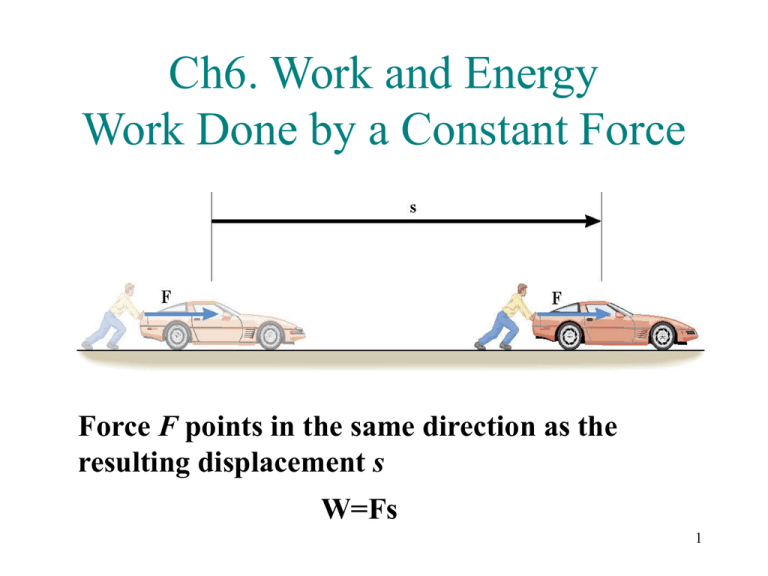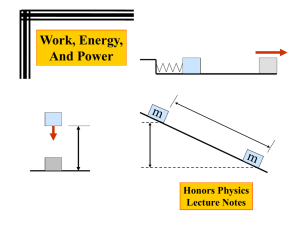Ch6. Work Done by a Constant Force
advertisement

Ch6. Work and Energy Work Done by a Constant Force Force F points in the same direction as the resulting displacement s W=Fs 1 W ( F cos )s SI Unit of Work: newton.meter=joule(J) Units of Measurement for Work System Force SI newton(N) meter(m) CGS dyne(dyn) centimeter(cm) erg BE pound(lb) foot(ft) foot.pound * Distance = Work joule(J) (ft.lb) 2 Example 1. Pulling a Suitcaseon-Wheels 3 Find the work done by a 45.0 N force in pulling the suitcase at an angle 50.0 for a distance s=75.0 m W ( F cos )s (45.0 N ) cos50.0(75.0m) 2170J No work done due to Fsin F and s in the same direction positive work F and s in the opposite direction negative work 4 Example 2. Bench-Pressing The weight lifter is bench-pressing a barbell whose weight is 710N. In part (b) of the figure, he raises the barbell a distance of 0.65m above his chest, and in part (c) he lowers it the same distance. 5 The weight is raised and lowered at a constant velocity. Determine the work done on the barbell by the weight lifter during (a) the lifting phase and (b) the lowering phase. (a) W ( F cos )s (710N ) cos0(0.65m) 460J (b) W ( F cos )s (710N ) cos180(0.65m) 460J cos1800 = -1 6 Example 3. Accelerating a Crate A 120kg crate on the flatbed of a truck that is moving with an acceleration of a=+1.5m/s2 along the positive x axis. The crate does not slip with respect to the truck, as the truck undergoes a displacement whose magnitude is s=65m. What is the total work done on the crate by all of the forces acting on it? 7 Forces that act on the crate: (1) the weight W=mg of the crate, (2) the normal force FN exerted by the flatbed, (3) the static frictional force fs. f s ma (120kg)(1.5m / s ) 180N 2 W ( f s cos )s (180N ) cos0(65m) 1.2 10 J 4 8 Check your understanding 1 A suitcase is hanging straight down from your hand as you ride an escalator. Your hand exerts a force on the suitcase and this force does work.Which one of the following statements is correct? (a) The work is negative when you ride up the escalator and positive when you ride down the escalator. (b) The work is positive when you ride up the escalator and negative when you ride down the escalator. (c) The work is positive irrespective of whether you ride up or down the escalator. (d) The work is negative irrespective of whether you ride up or down the escalator. Answer: (b) 9 The Work-Energy Theorem and Kinetic Energy 10 Concepts At a Glance: In physics, when a net force performs work on an object, there is always a result from the effort. The result is a change in the Kinetic energy. What is Kinetic Energy? Energy associated with motion. KE=(1/2)mv2 The relationship that relates work to the change in kinetic energy is known as the Work-energy theorem. 11 v v 2as s 2 f 2 0 v v 2 f 2 0 2a Definition of Kinetic Energy: The kinetic energy KE of an object with mass m and speed v is given by 1 2 KE mv 2 SI Unit of Kinetic Energy: joule(J) 12 ( F)s mas Work done by net ext. force ( F ) s Work done by net ext. force 1 2 1 2 mv f mv 0 2 2 Final KE Initial KE 13 The Work-Energy Theorem When a net external force does work W on an object, the kinetic energy of the object changes from its initial value of KE0 to a final value of KEf, the difference between the two values being equal to the work: 1 2 1 2 W KE f KE0 mv f mv 0 2 2 14 Example 4. Deep Space 1 15 The space probe Deep Space 1 was launched October 24, 1998. Its mass was 474kg. The goal of the mission was to test a new kind of engine called an ion propulsion drive, which generates only a weak thrust, but can do so for long periods of time using only small amounts of fuel. The mission has been spectacularly successful. Consider the probe traveling at an initial speed of v0=275m/s. No forces act on it except the 56.0-mN thrust of its engine. This external force F is directed parallel to the displacement s of magnitude 2.42*109 m. Determine the final speed of the probe, assuming that the mass remains nearly constant. 16 W ( F cos )s (56.0 103 N ) cos0(2.42109 m) =1.36*108 J 1 KE f W KE0 (1.36 10 J ) (474 kg )( 275 m / s) 2 2 8 =1.54*108 J vf 2( KE f ) m 2(1.54108 J ) =806 m/s 474kg 17 Example 5. Downhill Skiing 18 A 58 kg skier is coasting down a 250 slope. A kinetic frictional force of magnitude fk=70N opposes her motion. Near the top of the slope, the skier’s speed is v0=3.6m/s. Ignoring air resistance, determine the speed vf at a point that is displaced 57m downhill. 2 F mg sin 25 f ( 58 kg )( 9 . 80 m / s ) sin 25 70N k =+170 N 19 W ( F cos )s (170N ) cos0(57m) 9700J KEf=W+KE0=9700J+(1/2)(58kg)(3.6m/s)2=10100J vf 2( KE f ) m 2(10100J ) 19m / s 58kg 20 Check your understanding 2 A rocket is at rest on the launch pad. When the rocket is launched, its kinetic energy increases. Is the following statement true or false? “The amount by which the kinetic energy increases is equal to the work done by the force generated by the rocket’s engine.” Answer: False 21 Conceptual Example 6. Work and Kinetic Energy A satellite moving abut the earth in a circular orbit and in an elliptical orbit. The only external force that acts on the satellite is the gravitational force. For these two orbits, determine whether the kinetic energy of the satellite changes during the motion. In circular motion, F no work done. S always KE changes in the elliptical orbit, but not in the circular orbit. 22 Gravitational Potential Energy Work Done by the Force of Gravity Wgravity=(mg cos00)(h0-hf)=mg(h0-hf) 23 Example 7. A Gymnast on a Trampoline 24 A gymnast springs vertically upward from a trampoline. The gymnast leaves the trampoline at a height of 1.20m and reaches a maximum height of 4.80m before falling back down. All heights are measured with respect to the ground. Ignoring air resistance, determine the initial speed v0 with which the gymnast leaves the trampoline. Wgravity=mg (h0-hf) v0 2 g (h0 h f ) 2(9.80m / s 2 (1.20m 4.80m) =8.40 m/s 25 Gravitational Potential Energy Wgravity= mgh0 Initial gravitationa l potential energy PE0 mghf Final gravitational potential energy PEf 26 Definition of Gravitational Potential Energy The gravitational potential energy PE is the energy that an object of mass m has by virtue of its position relative to the surface of the earth. That position is measured by the height h of the object relative to an arbitrary zero level: PE=mgh SI Unit of gravitational potential energy: joule (J) 27 Conservative Versus Nonconservative Forces 28 Definition of a Conservative Force Version 1: A force is conservative when the work it does on a moving object is independent of the path between the object’s initial and final positions. Version 2: A force is conservative when it does no net work on an object moving around a closed path, starting and finishing at the same point. 29 Work done by external forces = i.e, KE 1 2 1 2 Wc Wnc mv f mv 0 2 2 1 2 1 2 mg (h0 h f ) Wnc mv f mv 0 2 2 30 1 2 1 2 Wnc ( mv f mv 0 ) (mgh f mgh 0 ) 2 2 Wnc = Net work done by nonconservative forces (KEf - KE0) Change in kinetic energy + (PEf - PE0) Change in gravitational potential energy Wnc KE PE 31 The Conservation of Mechanical Energy 32 Total mechanical energy: the sum of kinetic energy and gravitational potential energy E = KE + PE Wnc Wnc = (KEf - KE0) = + (PEf - PE0) (KEf + PEf) - (KE0 + PE0) Ef E0 Wnc = Ef - E0 33 Suppose Wnc=0J, so Ef = E0 1 2 mvf2+mghf = 1 2 mv02+mgh0 The principle of Conservation of Mechanical Energy The total mechanical energy (E=KE+PE) of an object remains constant as the object moves, provided that the net work done by external nonconservative forces is zero, Wnc=0J 34 35 36 Example 8. A Daredevil Motorcyclist 37 A motorcyclist is trying to leap across the canyon by driving horizontally off the cliff at a speed of 38.0 m/s. Ignoring air resistance, find the speed with which the cycle strikes the ground on the other side. (1/2)mvf2+mghf = (1/2) mv02+mgh0 v f v02 2 g (h0 h f ) v f (38.9m / s) 2(9.80 m / s )( 70.0m 35.0m) 2 2 =46.2 m/s 38 Check your understanding 3 Some of the following situations are consistent with the principle of conservation of mechanical energy, and some are not. Which ones are consistent with the principle? (a) An object moves uphill with an increasing speed. (b) An object moves uphill with a decreasing speed. (c) An object moves uphill with a constant speed. (d) An object moves downhill with an increasing speed. (e) An object moves downhill with a decreasing speed. (f) An object moves downhill with a constant speed. (b) And (d) 39 Conceptual Example 9. The Favorite Swimming Hole A rope is tied to a tree limb and used by a swimmer to swing into the water below. The person starts from rest with the rope held in the horizontal position, swings downward, and then lets go of the rope. 40 Three forces act on him: his weight, the tension in the rope, and the force due to air resistance. His initial height h0 and final height hf are known. Considering the nature of these forces, conservative versus non-conservative, can we use the principle of conservation of mechanical energy to find his speed vf at the point where he lets go of the rope? If Wnc= 0 (work due to nonconservative forces) conservation of energy Tension and air resistance --- non conservative T is always r to the circular path. So no work done by T. 41 Work done by air resistance is nonzero. So ideally no. But if ignore air resistance, 1 2 1 2 mv 0 mgh 0 mv f mgh f 2 2 v f v 2 g (h0 h f ) 2 0 42 Example 10. The Steel Dragon The tallest and fastest roller coaster in the world is now the Steel Dragon in Mie, Japan. The ride includes a vertical drop of 93.5m. The coaster has a speed of 3.0m/s at the top of the drop. Neglect friction and find the speed of the riders at the bottom. (1/2)mvf2+mghf = (1/2) mv02+mgh0 Ef E0 43 v f v0 2 g (h0 h f ) 2 vf (3.0m / s) 2(9.80 m / s )( 93.5m) 2 = 42.9m/s (about 96 mi/h) 44 Example 11. The Steel Dragon, Revisited In example 10, we ignored non-conservative forces, such as friction. In reality, however, such forces are present when the roller coaster descends. The actual speed of the riders at the bottom is 41.0 m/s, which is less than that determined in example 10. Assuming again that the coaster has a speed of 3.0 m/s at the top, find the work done by non-conservative forces on a 55.0kg rider during the descent from a height h0 to a height hf , where h0 – hf =93.5m 45 1 1 2 2 Wnc ( mv f mgh f ) ( mv 0 mgh 0 ) 2 2 Ef E0 1 2 2 Wnc m(v f v0 ) mg (h0 h f ) 2 1 Wnc (55.0kg )[( 41m / s ) 2 (3m / s ) 2 ] (55.0kg )( 9.80 m / s 2 )( 93.5m) 2 4400 J 46 Example 12. Fireworks A 0.20kg rocket in a fireworks display is launched from rest and follows an erratic flight path to reach the point P. Point P is 29m above the starting point. In the process, 425J of work is done on the rocket by the non-conservative force generated by the burning propellant. Ignoring air resistance and the mass lost due to the burning propellant, find the speed vf of the rocket at the point P. 47 1 1 2 2 Wnc ( mv f mgh f ) ( mv 0 mgh 0 ) 2 2 1 2 2[Wnc m v0 m g(h f h0 )] 2 vf m 1 2[425J (0.20kg )(0m / s) 2 (0.20kg )(9.80m / s 2 )(29m)] 2 vf 0.20kg =61m/s 48 Power The idea of power incorporates both the concepts of work and time, for power is work done per unit time. Definition of Average Power Average power P is the average rate at which work W is done, and it is obtained by dividing W by the time t required to perform the work. Work W P Time t SI Unit of Power: joule/s=watt (W) 49 Check your understanding 4 Engine A has a greater power rating than engine B. Which one of the following statements correctly describes the abilities of these engines to do work? (a) Engine A and B can do the same amount of work in the same amount of time. (b) In the same amount of time, engine B can do more work than engine A. (c) Engine A and B can do the same amount of work, but A can do it more quickly. Answer: (c) 50 Units of Measurement for Power System Work / Time SI joule (J) / second (s) = watt (W) CGS erg / second (s) BE foot.pound / second (s) = erg per second(erg/s) foot.pound per second (ft.lb) = = Power (ft.lb/s) 51 P change in energy Time 1horsepower 550 foot pound/ sec ond 745.7watts W Fs t t P Fv 52 Example 13. The Power to Accelerate a Car A 1.10*103kg car, starting from rest, accelerates for 5.00s. The magnitude of the acceleration is a=4.60m/s2. Determine the average power generated by the net force that accelerates the vehicle. F ma (1.1010 kg)(4.60m / s ) 5060N 3 2 53 1 1 v (v 0 v f ) v f 2 2 v f v0 at (0m / s) (4.60m / s 2 )(5.00s) 23.0m / s P F v (5060N )(11.5m / s) 5.82104W (78.0hp) 54 Other Forms of Energy and the Conservation of Energy Examples: electrical energy, heat, chemical energy, nuclear energy…. In general, energy of all types can be converted from one form to another. The principle of conservation of energy Energy can neither be created nor destroyed, but can only be converted from one form to another. 55 Work Done by a Variable Force The work done by a variable force in moving an object is equal to the area under the graph of Fcos versus s. 56 W ( F cos )1 s1 ( F cos ) 2 s2 57 Example 14. Work and the Compound Bow Find the work that the archer must do in drawing back the string of the compound bow from 0 to 0.500 m J W (242squares)(0.250 ) 60.5 J square 58 Example 15. Skateboarding and Work The skateboarder is coasting down a ramp, and there are three forces acting on her: her weight W (magnitude = 675 N), a frictional force f ( magnitude = 125 N). That opposes her motion, and a normal force FN (magnitude =612 N). Determine the net work done by the three forces when she coasts for a distance of 9.2 m. 59 60 W= (Fcos) s Force F Angle S W 675N 65.00 9.2m W=(675N)(cos 65.00)(9.2m)=+2620J f 125N 180.00 9.2m W=(125N)(cos 180.00)(9.2m)=-1150J FN 612N 90.00 9.2m W=(612N)(cos 90.00)(9.2m)=0J The net work done by the three forces is +2626J+(-1150J)+0J=+1470J 61 Concepts & Calculations Example 16. Conservation of Mechanical Energy and the Work-Energy Theorem hA 62 A 0.41kg block sliding from A to B along a frictionless surface. When the block reaches B, it continues to slide along the horizontal surface BC. The block slows down, coming to rest at C. The kinetic energy of the block at A is 37J, and the height of A and B are 12m and 7m above the ground. (a) What is the kinetic energy of the block when it reaches B? (b) How much work does the kinetic frictional force do during the BC segment of the trip? 63 A---B motion: What are the forces? Weight--------------- conservative Normal force-------- non conservative What is the non conservative work (Wnc) ? Wnc=0 FN displacement Conservation of energy valid for A---B? K. E at B ? K. E at A K. E at B < K. E at A 64 (a) KEB + mghB = KEA + mghA KEB = KEA + mg(hA-hB) =37J+(0.41kg)(9.80m/s2)(12m-7m) =57J 65 (b) For BC Trip, is total energy conserved? Why? No Then (Friction Wnc) Wnc= KEC + mghC - (KEB+mghB) Wnc= KEC - KEB+mg(hC-hB) 0J 0m Wnc= -KEB= -57J 66 Problem 2 T T REASONING AND SOLUTION Each locomotive does work W = T(cos) s= (5.00*103 N) cos 20.0° (2.00 * 103 m) = 9.40*106 J The net work is then WT = 2W = 2T(cos) s = 1.88 × 107 J 67 Problem 16 8450 m/s perigee 2820 m/s apogee 68 From the work-energy theorem, W 1 2 mvf 2 1 2 mv0 2 1 2 m vf 2 2 v0 a) 11 11 b) W 1 (7420 kg) (2820 m/s)2 (8450 m/s)2 = –2.35 2 . 35 10 10 JJ 2 69 Problem 20 16 kg F = 24N 8.0 M v0 = 0 vf = 2.0 m/8 FN P fk fk = μk FN mg FN-mg=0 FN=mg To find the work, employ the work-energy theorem, W = KEf KE0 70 Work done by the net force (pulling force P and fk) W= W pulling + W f SOLUTION According to the work-energy theorem, we have W = Wpull + Wf = KEf KE0 Using Equation 6.1 [W = (F cos θ) s] to express each work 2 1 , and contribution, writing the kinetic energy as mv 2 noting that the initial kinetic energy is zero (the sled starts from rest), we obtain P cos 0 ) s f k cos180 ) s Wpull Wf 1 2 mv 2 71 The angle θ between the force and the displacement is 0º for the pulling force (it points in the same direction as the displacement) and 180º for the frictional force (it points opposite to the displacement). Equation 4.8 indicates that the magnitude of the frictional force is fk = μkFN, and we know that the magnitude of the normal force is FN = mg. With these substitutions the work-energy theorem becomes P cos 0) s k mg cos180) s Wpull 1 2 mv 2 Wf Solving for the coefficient of kinetic friction gives mv P cos 0 ) s k mg cos180) s 1 2 2 1 2 16 kg ) 2.0 m/s ) 24 N )8.0 m ) 16 kg ) 9.80 m/s 2 ) 8.0 m ) 2 72 0.13 Problem 26 REASONING The work done by the weight of the basketball is given by Equation 6.1 as W F cos ) s , where F = mg is the magnitude of the weight, is the angle between the weight and the displacement, and s is the magnitude of the displacement. The drawing shows that the weight and displacement are parallel, so that = 0. The potential energy of the basketball is given by Equation 6.5 as PE = mgh, where h is the height of the ball above the ground. 6.1 m mg s =0.6g 1.5 m 73 SOLUTION a. The work done by the weight of the basketball is W F cos ) s = mg (cos 0)(h0 hf) = (0.60 kg)(9.80 m/s2)(6.1 m 1.5 m) = 27 J b. The potential energy of the ball, relative to the ground, when it is released is PE0 = mgh0 = (0.60 kg)(9.80 m/s2)(6.1 m) = 36 J 74 c. The potential energy of the ball, relative to the ground, when it is caught is PEf = mghf = (0.60 kg)(9.80 m/s2)(1.5 m) = 8.8 J d. The change in the ball’s gravitational potential energy is PE = PEf PE0 = 8.8 J – 36 J = 27 J We see that the change in the gravitational potential energy is equal to –27 J = W , where W is the work done by the weight of the ball (see part a). 75 Problem 34 Total mechanical energy conserved? Yes (W—conservative FN 1 mv 2 f 2 hf h0 14.0 m/s ) 2 mghf 13.0 m/s ) 2 9.80 m/s 2 ) displacement) 1 mv 2 0 2 mgh0 2 1.4 m 76 Problem 41 REASONING Friction and air resistance are being ignored. The normal force from the slide is perpendicular to the motion, so it does no work. Thus, no net work is done by nonconservative forces, and the principle of conservation of mechanical energy applies. 77 SOLUTION Applying the principle of conservation of mechanical energy to the swimmer at the top and the bottom of the slide, we have 1 1 2 2 mvf mghf mv0 mgh0 2 2 Ef E0 If we let h be the height of the bottom of the slide above the water, hf h, and h0 H. Since the swimmer starts from rest, v0 0 m/s, and the above expression becomes 1 2 vf 2 gh gH 78 Solving for H, we obtain vf2 H h 2g Before we can calculate H, we must find vf and h. Since the velocity in the horizontal direction is constant, x 5.00 m vf 10.0 m /s t 0.500 s 79 The vertical displacement of the swimmer after leaving the slide is, from Equation 3.5b (with down being negative), ) 1 2 1 2 2 y a y t 9.80 m / s 0.500 s ) 1.23m 2 2 Therefore, h = 1.23 m. Using these values of vf and h in the above expression for H, we find vf2 (10.0 m/s)2 H h 1.23 m 2 6.33 m 2g 2(9.80 m/s ) 80 Problem 43 60 r rcos60 r PE=0 mv r FC 2 T mg m v2 T mg r This is the max tension. 81 REASONING AND SOLUTION At the bottom of the circular path of the swing, the centripetal force is provided by the tension in the rope less the weight of the swing and rider. That is, mv r 2 T mg FC Solving for the mass yields m T 2 v g r 82 The energy of the swing is conserved if friction is ignored. The initial energy, E0, when the swing is released is completely potential energy and is E0 = mgh0, Conservation of energy PEini + KEini = PEf + KEf mgh0 + 0 = 0 + (1/2)mvf2 vf = 2gh0 gr 1r h0 = r (1 – cos 60.0°) = 2 r=2h0 83 The expression for the mass now becomes T T m 2 2 gh0 v g g r r T T g g 2g 2 8.00 10 N T m 40.8 kg 2 g 2 9.80 m/s2 ) 84 Problem 48 No air friction. 18.0 m/s m=0.75kg 85 a. Since there is no air friction, the only force that acts on the projectile is the conservative gravitational force (its weight). The initial and final speeds of the ball are known, so the conservation of mechanical energy can be used to find the maximum height that the projectile attains. The conservation of mechanical energy, as expressed by Equation 6.9b, states that 1 mv 2 f 2 mghf Ef 1 mv 2 0 2 mgh0 E0 86 The mass m can be eliminated algebraically from this equation since it appears as a factor in every term. Solving for the final height hf gives hf 1 2 2 v0 2 vf )h 0 g Setting h0 = 0 m and vf = 0 m/s, the final height, in the absence of air resistance, is hf 2 vo 2g 2 vf 18.0 m / s ) 0 m/s ) 2 2 9.80 m / s 2 ) 2 16.5 m 87 b. When air resistance, a non-conservative force, is present, it does negative work on the projectile and slows it down. Consequently, the projectile does not rise as high as when there is no air resistance. The work-energy theorem, in the form of Equation 6.6, may be used to find the work done by air friction. Then, using the definition of work, Equation 6.1, the average force due to air resistance can be found. The work-energy theorem is Wnc 1 mv 2 f 2 1 mv 2 0 2 ) mgh f mgh0 ) 88 where Wnc is the non-conservative work done by air resistance. According to Equation 6.1, the work can be written as Wnc (F R cos180)s , where F is the average R force of air resistance. As the projectile moves upward, the force of air resistance is directed downward, so the angle between the two vectors is = 180 and cos = –1. The magnitude s of the displacement is the difference between the final and initial heights, s = hf – h0 = 11.8 m. With these substitutions, the work-energy theorem becomes FR s 1m 2 2 vf 2 vo ) mg hf h0 ) 89 Solving for FR gives FR 1 m v2 f 2 ) vo2 mg hf h0 ) s 1 2 ) 2 2 2 0.750 kg 0 m/s 18.0 m/s 0.750 kg 9.80 m/s ) ) ) ) 11.8 m ) 11.8 m ) 2.9 N 90 Problem 57 REASONING AND SOLUTION One is the amount of work or energy generated when one kilowatt of power is supplied for a time of one hour. From Equation 6.10a, we know that W P t . Using the fact that 1 kW = 1.0 10 3 J/s and that 1h = 3600 s, we have 3 3 6 1.0 kWh = (1.0 10 J/s)(1 h) = (1.0 10 J/s)(3600 s)= 3.6 10 J 91 Problem 60 friction REASONING AND SOLUTION mg 37 a. The power developed by the engine is P = Fv = (2.00 * 102 N)(20.0 m/s) = 4.00 103 W 92 b. The force required of the engine in order to maintain a constant speed up the slope is F = Fa + mg sin 37.0° The power developed by the engine is then P = Fv = (Fa + mg sin 37.0°)v P = [2.00 * 102 N + (2.50 * 102 kg)(9.80 m/s2)sin 37.0°](20.0 m/s) = 3.35 10 4 W 93








